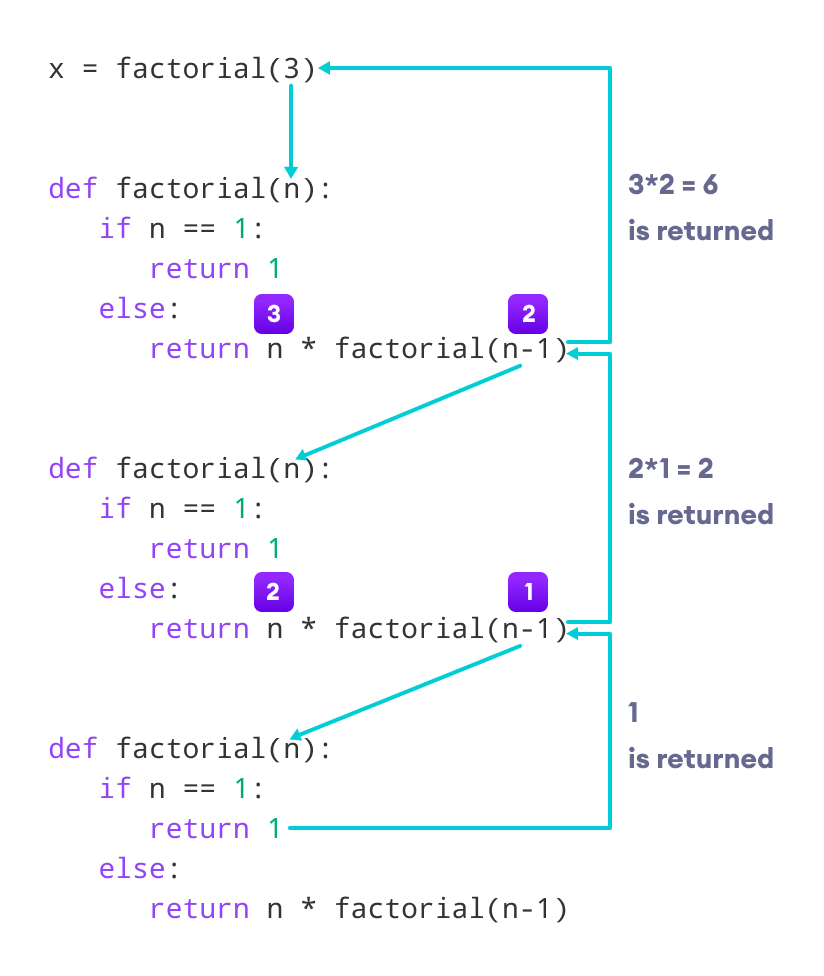📌 相关文章
- Python中的递归
- Python递归
- Python递归(1)
- Python递归
- Python中的递归(1)
- python 递归示例 - Python (1)
- 递归 python 示例 - Python (1)
- python代码示例中的递归
- C-递归
- 尾递归(1)
- C递归
- 尾递归
- C中的递归(1)
- 递归
- 尾递归
- c++中的递归幂(1)
- C++ 递归(1)
- C递归(1)
- C-递归(1)
- C++ 递归
- C++递归
- 头与尾递归 (1)
- C++递归(1)
- 递归(1)
- C中的递归
- 递归类方法python(1)
- python 递归示例 - Python 代码示例
- 递归 python 示例 - Python 代码示例
- c++代码示例中的递归幂
📜 Python递归
📅 最后修改于: 2020-09-19 14:11:49 🧑 作者: Mango
在本教程中,您将学习创建一个递归函数 (一个调用自身的函数 )。
什么是递归?
递归是根据自身定义某些内容的过程。
一个物理世界的例子是放置两个相互面对的平行反射镜。它们之间的任何对象都将递归地反映出来。
Python递归函数
在Python,我们知道一个函数可以调用其他函数。 函数甚至可能会自行调用。这些类型的构造称为递归函数。
下图显示了称为recurse的递归函数的工作。

以下是查找整数的阶乘的递归函数的示例。
数字的阶乘是从1到该数字的所有整数的乘积。例如,阶乘6(表示为6!)为1*2*3*4*5*6 = 720 。
递归函数示例
def factorial(x):
"""This is a recursive function
to find the factorial of an integer"""
if x == 1:
return 1
else:
return (x * factorial(x-1))
num = 3
print("The factorial of", num, "is", factorial(num))输出
The factorial of 3 is 6在上面的示例中, factorial()是它自己调用的递归函数 。
当我们用正整数调用此函数时,它将通过减少数量来递归调用自身。
每个函数将数字乘以其下面的数字的阶乘,直到等于1。可以在以下步骤中解释此递归调用。
factorial(3) # 1st call with 3
3 * factorial(2) # 2nd call with 2
3 * 2 * factorial(1) # 3rd call with 1
3 * 2 * 1 # return from 3rd call as number=1
3 * 2 # return from 2nd call
6 # return from 1st call让我们看一下显示发生了什么的逐步过程的图像:

当数字减少到1时,递归结束。这称为基本条件。
每个递归函数必须具有停止递归的基本条件,否则该函数将无限调用自身。
Python解释器限制了递归的深度,以帮助避免无限递归,从而导致堆栈溢出。
默认情况下,最大递归深度为1000 。如果超出限制,则将导致RecursionError 。让我们看一个这样的条件。
def recursor():
recursor()
recursor()输出
Traceback (most recent call last):
File "", line 3, in
File "", line 2, in a
File "", line 2, in a
File "", line 2, in a
[Previous line repeated 996 more times]
RecursionError: maximum recursion depth exceeded 递归的优点
- 递归函数使代码看起来简洁明了。
- 可以使用递归将复杂的任务分解为更简单的子问题。
- 使用递归比使用嵌套嵌套更容易生成序列。
递归的缺点
- 有时,递归背后的逻辑很难遵循。
- 递归调用很昂贵(效率低),因为它们占用大量内存和时间。
- 递归函数很难调试。